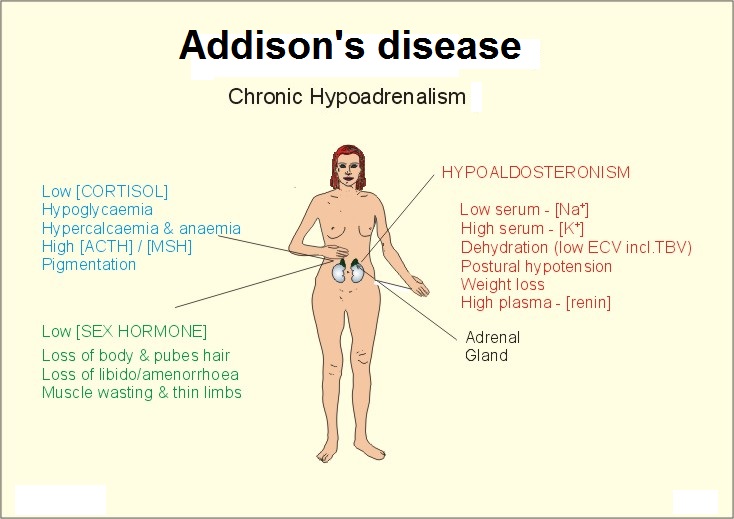Addison's Disease Case Study
Author/s
Chris Hartlage, Braden Hurst, Lee Janasek, Michael Porter and Jordan Thomas from the Bellarmine University Physical Therapy Program's Pathophysiology of Complex Patient Problems Project.
Abstract[edit | edit source]
Addison’s disease is characterized by a lack of hormone production by the adrenal glands. The adrenal gland produces too little cortisol and often too little aldosterone. Addison’s disease is also called adrenal insufficiency and can occur in all ages while affecting both genders. Addison’s disease usually develops slowly over several months, but sometimes signs and symptoms can appear rapidly. Addison’s disease can even be life threatening if left untreated. Some signs and symptoms of Addison’s disease include muscle weakness, fatigue, weight loss, decreased appetite, hyperpigmentation and depression.
Patient Characteristics[edit | edit source]
Demographics: 21 year old Caucasian male, part time package handler at UPS
Co-morbidities: Hypoglycemia
Previous care: Patient has had previous physical therapy for an ACL repair after an injury playing soccer in 2010.
Examination[edit | edit source]
- Subjective: Jack E. Robinson, a 21 year old Caucasian male who lives with his parents, reports to your clinic with a chief complaint of gradual onset of weakness and fatigue. Jack works at United Parcel Service (UPS) at night while attending the local community college during the day. His work duties require him to lift boxes up to 60 lbs. by himself and he has been struggling to do so in recent months, even becoming dizzy and nearly fainting a few times. He has used almost all of his sick days due to feeling nauseous and vomiting while at work and occasionally before coming to work. He also stated that lately he has been having pain in both his knees and elbows while at work. He reported a slight decrease in his weight and not being hungry nearly as often. He used to stop by the 24 hour Subway for a sandwich every night after work, but only goes one or two times per week in recent months. Now when he goes the sandwiches taste bland and he has to use a lot of salt to make them taste better. He states being nervous about eating certain foods when he is hungry due to diarrhea which he has not figured out the cause of. When asked, he states that his tanned skin from the summer has not faded like it usually does even though it is well into the winter months (January) and that he does not use a tanning bed. He states his parents are worried because he is quick to become irritated with them and rarely comes out of his room when at home.
- Services: Jack has seen his primary care physician twice since the onset of symptoms and last time was referred to PT with a prescription that said “evaluate and treat for weakness and fatigue”. He has received no other care for his current condition.
- Patient Goals: increase strength and stamina in order to return to peak performance levels at work and so that workout regimen can resume.
- Self-Report Outcome Measures: ODI, FABQ, SANE
- Physical Performance Measures: 6 minute walk test, 10 time STS
- Objective:
Vitals:
HR:78
BP: 106/54
RR: 16
ROM:
All ROM within normal limits
MMT:
Shoulder Flexion: 4+/5
Shoulder Ext: 4+/5
Shoulder Abd: 4/5
Shoulder IR: 4/5
Shoulder ER: 4/5
Elbow Flex: 4+/5 painful
Elbow Ext: 4+/5 painful
Hip Flex: 4+/5
Hip Ext: 4-/5
Hip Abd: 4-/5
Hip Add: 4+/5
Hip IR: 4/5
Hip ER: 4-/5
Knee Flex: 4+/5 painful
Knee Ext: 4+/5 painful
All other MMT WNL
Sensation/Reflexes:
All WNL
Observation:
Unusally tan skin
Clinical Impression[edit | edit source]
Summarization of Examination Findings[edit | edit source]
Patient displays generalized muscle weakness, weight loss due to a decrease in appetite, joint pain, salt cravings, nausea, diarrhea, and vomiting. Aerobic exercise will be implemented to address generalized weakness and fatigue. A strengthening program will also be implemented to address the generalized muscle weakness and fatigue.
Intervention[edit | edit source]
- Phases of Interventions (e.g. protective phase, mobility phase, etc.)
- Dosage and Parameters
- Rationale for Progression
- Co-interventions if applicable (e.g. injection therapy, medications)
Outcomes[edit | edit source]
Due to Mr. Robinson's young age, high motivation, and experience in physical therapy for his ACL repair, his prognosis is very good. The first treatment session went well and Mr. Robinson was surprised how much he was able to do without getting fatigued. The squats and weighted knee extensions had to be discontinued due to knee pain but he was able to complete the lunge matrix. He will benefit from continued skilled PT to continue to work on his functional exercises so that he may return to work with little no fatigue. After 4 weeks of therapy, Mr. Robinson reports no pain in his elbows or knees and tolerates 2-3 hours of therapy a day. He has gone back to work and feels confident in all his lifting responsibilities. He continues to feel fatigued, but states that he is continuing to progress and is able to go longer distances on his walks and has progressed to riding the bike for 20 minutes at a time. His nutritionist has him on a meal plan that has decreased his nausea, vomiting and diarrhea and he has been eating his normal amount. The medications and hormones his MD prescribed has helped with the pigment of his skin and also helped with his irritation at home which has made his parents happy as well.
Discussion[edit | edit source]
Summary Statement which should include related findings in the literature, potential impact on clinical practices
Related Pages[edit | edit source]
Addison’s disease: http://www.physio-pedia.com/Addison%27s_Disease
Addison's Disease Self-Help Group: Owner's Manual: http://www.addisons.org.uk/info/manual/adshgguidelines.pdf
National Endocrine and Metabolic Diseases Information Service: http://endocrine.niddk.nih.gov/index.aspx
National Adrenal Diseases Foundation: http://www.nadf.us/
References[edit | edit source]
References will automatically be added here, see adding references tutorial.
- ↑ Addison’s disease: Medical Assessment Online. http://medicalassessmentonline.com/terms.php?R=5. Accessed March 26, 2015.







